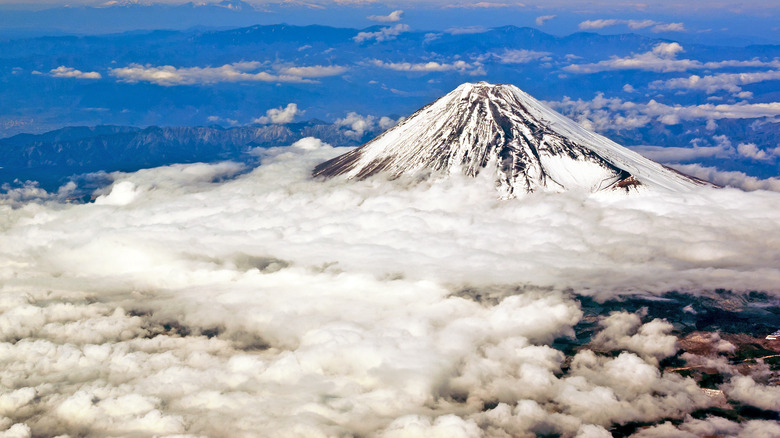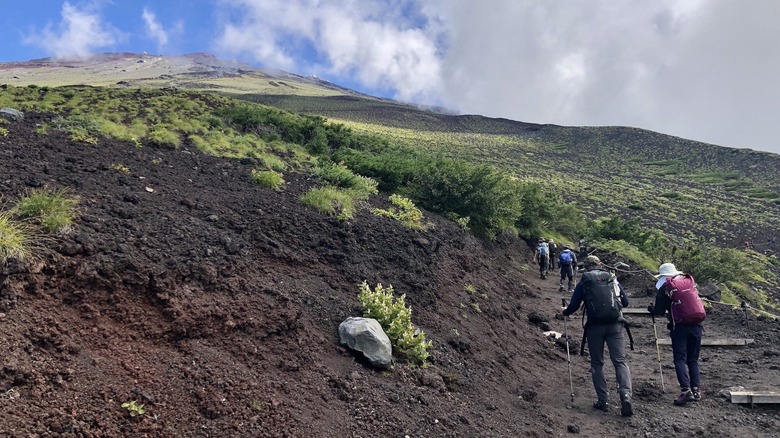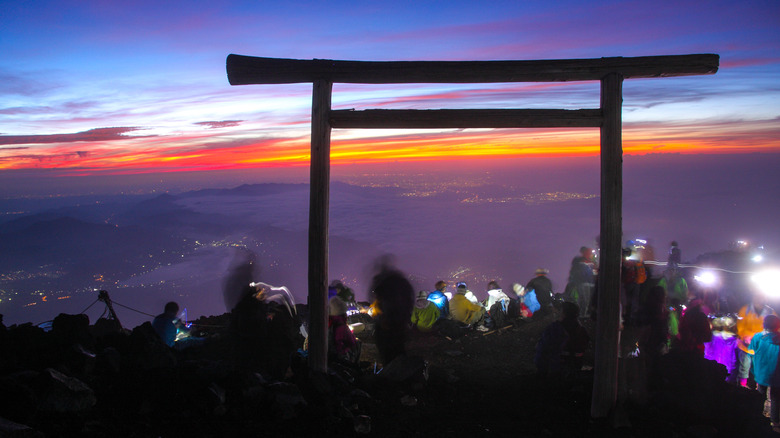Hike To A Breathtaking Mountain Top At This National Park In Japan
If you're flying out of Haneda Airport in Tokyo, you might look out the window after about 10 or 15 minutes and see a volcano cone peeking over the clouds. Mount Fuji, the country's tallest mountain, stands 12,388 feet, so high that its almost perfectly formed cone is often visible from passing planes. It's one of Asia's most-filmed locations, and is right up there with cherry blossoms and the bullet train as an instantly recognizable symbol of Japan.
In the air or on the ground, the sight of Mount Fuji in person can be majestic. Just imagine being on top of Fujisan (as it's known in Japanese), watching the sunrise from the country's highest peak. Chasing that experience is what compels many hikers to visit Fuji-Hakone-Izu National Park and ascend Mount Fuji during the climbing season from July to early September.
Taking in over 70 million visitors even in pandemic years, Fuji-Hakone-Izu National Park is, far and away, Japan's most-visited national park. Yet it's a little different than what you might expect from U.S. national parks, localized around a specific landmark like the Grand Canyon. This is because the park is spread out across multiple prefectures and encompasses a wide range of natural features and population centers. It extends 474 square miles from land to sea, though its defining trait could be regarded as the volcanic landscape. When you're soaking in a hot spring in Japan's most-visited resort area, Atami, you might not even realize you're in a national park.
Climbing Mount Fuji via the Fujinomiya and Yoshida trails
Mount Fuji has four hiking trails leading up from the two neighboring prefectures it straddles in Chubu, Japan's central region. Three of the trails are in Shizuoka Prefecture and the other one is in Yamanashi Prefecture. The shortest route to the top of the mountain, and the only one where you'll ascend and descend the same path, is the Fujinomiya trail in Shizuoka. It starts at the highest altitude, about 2,400 meters, or 7,875 feet, above sea level. From Shinkansen (bullet train) stations like Shizuoka and Shin-Fuji, to local stations like Fuji and Fujinomiya, you can take a direct bus to Mount Fuji's 5th station and access this trail, pictured above.
Each trail has its own 5th station where cars and buses stop, and the climbing starts. The Yoshida trail is usually the most crowded because it offers sunrise views and is on the Yamanashi side of the mountain, closer to Tokyo and the popular Fuji Five Lakes area. It also has the most mountain huts, where you can sleep and have a hot meal on the way up overnight to see the sunrise. (Reservations are recommended.)
In 2023, a regulation was instated on the Yoshida trail throughout part of the climbing season, requiring hikers to pause when the trail is too congested and wait for others to advance. However, it all might be worth it when you get to the top with everyone else and behold the sunrise.
Other trails and sights in Fuji-Hakone-Izu National Park
Back on the Shizuoka side of Mount Fuji, another climbing option is the Subashiri trail. Like the Yoshida trail, it offers sunrise views. However, it's less crowded and some locals and English-speaking guides (like Fuji Mountain Guides) prefer it. For experienced hikers, the Gotemba trail is the longest and most challenging, though it comes with the eventual reward of sliding down the "Great Sand Run." You'll sometimes encounter thick fog here, but that can happen on any trail as clouds shroud the mountain in mist and mystery.
Remember that reaching the mountaintop is only the halfway point of what could be more than a half-day journey, counting rest hours in huts. At higher elevations, as the oxygen levels drop, Mount Fuji can literally take your breath away. Follow basic hiking safety tips and wear appropriate clothes and footwear. The mountain gets cold — even in summer — and the volcanic rock can be treacherous.
Though Mount Fuji takes the lead in the name, it's just the beginning of what there is to see in Fuji-Hakone-Izu National Park. Growing out of hardened lava, the nearby Sea of Trees, Aokigahara, has a beauty that belies its notoriety as the "suicide forest." From the lava caves of the Fuji Five Lakes area to Hakone's steaming "hell valley," Owakudani, to the hot springs of the Izu Peninsula and Izu Islands, Fuji-Hakone-Izu National Park will keep you busy with volcano sights long after the climbing is done.


